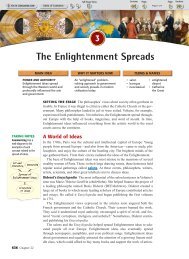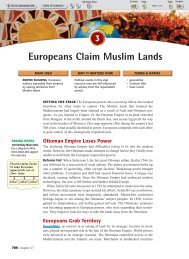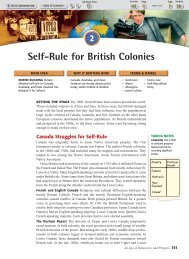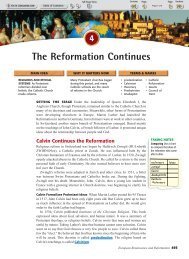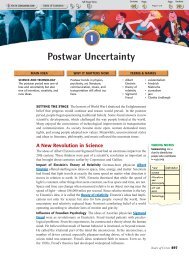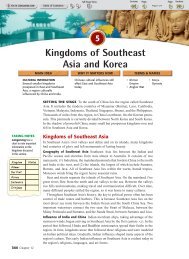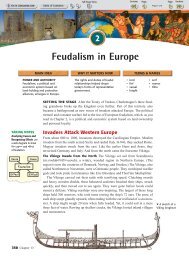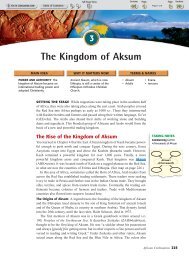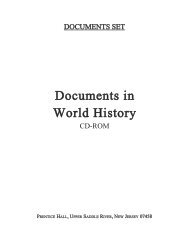Cold War: Superpowers Face Off - Mr. Trainor's Page
Cold War: Superpowers Face Off - Mr. Trainor's Page
Cold War: Superpowers Face Off - Mr. Trainor's Page
Create successful ePaper yourself
Turn your PDF publications into a flip-book with our unique Google optimized e-Paper software.
16° EThe Berlin AirliftFrom June 1948 to May 1949, Allied planestook off and landed every three minutes inWest Berlin. On 278,000 flights, pilots broughtin 2.3 million tons of food, fuel, medicine, andeven Christmas gifts to West Berliners.Divided Germany, 1948–1949TegelBERLINDENMARKGatow TempelhofHamburgNETH.HanoverBELG.WESTGERMANYEASTGERMANY50° NLUX.MainzCZECHOSLOVAKIAFRANCEFreiburgSWITZ.0 200 Miles8° EBaden-BadenMunich0 400 KilometersITALYAUSTRIAOccupation zonesBritishFrenchSovietU.S.Air corridorAirportSummarizingWhat Sovietactions led to theBerlin airlift?their idea of reunifying Germany. But American and British officials flew food andsupplies into West Berlin for nearly 11 months. In May 1949, the Soviet Unionadmitted defeat and lifted the blockade.The <strong>Cold</strong> <strong>War</strong> Divides the WorldThese conflicts marked the start of the <strong>Cold</strong> <strong>War</strong> between the United States and theSoviet Union. A cold war is a struggle over political differences carried on bymeans short of military action or war. Beginning in 1949, the superpowers usedspying, propaganda, diplomacy, and secret operations in their dealings with eachother. Much of the world allied with one side or the other. In fact, until the SovietUnion finally broke up in 1991, the <strong>Cold</strong> <strong>War</strong> dictated not only U.S. and Soviet foreignpolicy, but influenced world alliances as well.<strong>Superpowers</strong> Form Rival Alliances The Berlin blockade heightened WesternEurope’s fears of Soviet aggression. As a result, in 1949, ten western Europeannations joined with the United States and Canada to form a defensive militaryalliance. It was called the North Atlantic Treaty Organization (NATO). An attack onany NATO member would be met with armed force by all member nations.The Soviet Union saw NATO as a threat and formed it’s own alliance in 1955. Itwas called the <strong>War</strong>saw Pact and included the Soviet Union, East Germany,Czechoslovakia, Poland, Hungary, Romania, Bulgaria, and Albania. In 1961, the EastGermans built a wall to separate East and West Berlin. The Berlin Wall symbolizeda world divided into rival camps. However, not every country joined the newalliances. Some, like India, chose not to align with either side. And China, the largestCommunist country, came to distrust the Soviet Union. It remained nonaligned.The Threat of Nuclear <strong>War</strong> As these alliances were forming, the <strong>Cold</strong> <strong>War</strong>threatened to heat up enough to destroy the world. The United States already hadatomic bombs. In 1949, the Soviet Union exploded its own atomic weapon.President Truman was determined to develop a more deadly weapon before theSoviets did. He authorized work on a thermonuclear weapon in 1950.Restructuring the Postwar World 969



